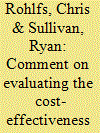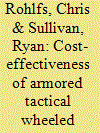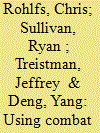| Srl | Item |
| 1 |
ID:
123169


|
|
|
|
|
| Publication |
2013.
|
| Summary/Abstract |
This comment discusses the pros and cons of the methodology and data used in our previous study on the cost-effectiveness of armor on Tactical Wheeled Vehicles (TWVs), and responds to recent critiques by Franz Gayl. In our previous article, we evaluated the large-scale Army policies to replace relatively light Type 1 Tactical Wheeled Vehicles (TWVs) with moderately protected Type 2 variants, and later to replace Type 2s with heavily protected Type 3s. We find that the switch from Type 2 to Type 3 TWVs did not appreciably reduce fatalities and were not cost-effective. Mr. Gayl contends that the data and choice of control variables used in our original study negatively bias our findings for Type 3 TWVs. We defend our previous conclusions and argue that Gayl's suggested approach of focusing on deaths per insurgent attack fails to account for effects of the vehicles on when, where, and how attacks occurred. Our methodology does not suffer from this bias and measures effects on total unit casualties rather those incurred per attack. We explain that our estimates are stable across many specifications and are not sensitive to the choice of controls as Gayl suggests.
|
|
|
|
|
|
|
|
|
|
|
|
|
|
|
|
| 2 |
ID:
121745


|
|
|
|
|
| Publication |
2013.
|
| Summary/Abstract |
This study uses for official use only data on US military operations to evaluate the large-scale Army policies to replace relatively light Type 1 tactical wheeled vehicles (TWVs) with more heavily protected Type 2 variants and later to replace Type 2s with more heavily protected Type 3s. We find that Type 2 TWVs reduced fatalities at $1.1 million-$24.6 million per life saved for infantry units, with our preferred cost estimates falling below the $7.5?million cost-effectiveness threshold, and did not reduce fatalities for administrative and support units. We find that replacing Type 2 with Type 3 TWVs did not appreciably reduce fatalities and was not cost-effective.
|
|
|
|
|
|
|
|
|
|
|
|
|
|
|
|
| 3 |
ID:
140258


|
|
|
|
|
| Summary/Abstract |
This study investigates the effect that US medical personnel deaths in combat have on other unit deaths and ‘military success,’ which we measure using commendation medals as a proxy. We use a difference-in-differences identification strategy, measuring the changes over time in these outcomes following the combat loss of a medic or doctor and comparing it to the changes following the combat loss of a soldier who is not a medic or doctor. We find that overall unit deaths decrease in the five or ten days following the deaths of medical personnel in Vietnam, Korea, and the Pacific theater in World War II (WWII). In contrast, the WWII European and North African results indicate that overall unit deaths rise following medical personnel deaths. We find no relationship between medical personnel deaths and other unit deaths in Iraq and Afghanistan. For Korea and the Pacific theater of WWII, our estimates suggest unit commendation medals decrease following the deaths of medical personnel. This pattern of evidence is consistent with a model in which units often halted aggressive tactical maneuvers and reduced pursuit of their military objectives until deceased medical personnel were replaced. The results for the other conflicts are mixed and show little connection between medical personnel deaths and commendation medals.
|
|
|
|
|
|
|
|
|
|
|
|
|
|
|
|